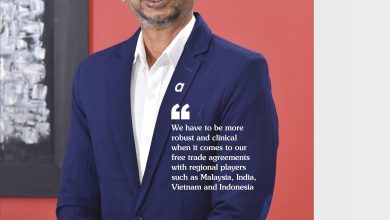APPAREL INDUSTRY
THE EVOLVING GROWTH CURVE
Pubudu De Silva elaborates on why Sri Lanka is ahead of its regional peers
Compiled by Isanka Perera
 Q: Could you provide an overview of Sri Lanka’s textile, apparel and manufacturing landscape?
Q: Could you provide an overview of Sri Lanka’s textile, apparel and manufacturing landscape?
A: The apparel industry, which is one of the pillars of Sri Lanka’s economy, has come a long way since its early days. Today, it generates an estimated 40 percent of the country’s export earnings.
However, the pandemic has taken a heavy toll on the industry’s progress; and the market, which was valued at US$ 5.3 billion in 2019, has dipped to 4.1 billion dollars of late. The loss was expected to be much greater but timely strategies helped the industry absorb the blows better; and despite the challenges faced, we were able to reach US$ 5.1 billion last year.
Therefore, I believe it is right to say that Sri Lanka’s textile, apparel and manufacturing foothold is quite resilient.
Q: What is your assessment of the global textile market – and where does Sri Lanka stand?
A: The online tool just-style.com, which is a network with a combined readership of some 55 million industry professionals, recently ranked Sri Lanka in 11th place among the top apparel sourcing countries to watch out for this year.
While Vietnam and Turkey head the list, Sri Lanka is currently positioned above regional peers such as Bangladesh (in 12th place) and India, which is further down the list in 16th position, followed by Pakistan at No. 18. This is testimony to the remarkable presence of Sri Lanka in the world apparel market.
Some of the key determining factors at the global level are price, production quality, lead time, innovation, reliability and flexibility. Sri Lanka is also recognised as being sustainability compliant.
Q: Against such a backdrop, what needs to be done to sustain the industry’s growth in the long term?
A: It can be seen in the global textile, apparel and manufacturing arenas that the situation is now in our favour.
For instance, the ongoing US-China trade war has accelerated a shift of apparel factories from China to other countries. While there will be no easy successor
to China’s manufacturing reign, these factories are leaning towards the Asian region.
Global fashion brands are drifting away from cotton and other goods produced in Xinjiang, following allegations of widespread human rights abuses and forced labour in the region.
Since our business climate doesn’t seem ideal, particularly in regard to attracting much needed investments, we have to work towards a more stable social environment as well as a growing economy – because it’s critical that Sri Lanka’s business confidence index improves.
In addition, the five point framework formulated by the Joint Apparel Association Forum (JAAF) to coordinate the industry’s responses to challenges posed by the pandemic is proving to be effective in driving stakeholder collaboration and ensuring the sustained long-term growth of Sri Lanka’s apparel industry.
Q: What impediments are undermining the growth of the apparel industry?
A: Over a period spanning several decades, Sri Lanka’s apparel industry has faced many obstacles.
Emerging from quota restrictions as one of the main garment exporters in the South Asian region, the industry then faced a civil war, during which time exporters were compelled to continue doing business without GSP+ concessions. In more recent years, the 2019 Easter Sunday bombings tapered the economy to some extent while the pandemic has created unprecedented challenges.
The strategy has to account for ‘customer pain points’ and proactively provide solutions that will automatically place it ahead of the competition.
Until recently, logistics-related issues were another key challenge – with the consequences being difficulties in sourcing material and exorbitant prices.
In times of crisis, it is necessary to remember that challenges are inevitable and how one navigates the hurdles determines the longevity of any industry. An ideal example would be Bangladesh – how it grew its revenue in apparel exports in spite of all the obstacles it faced.
If Sri Lanka has the necessary infrastructure in place, I believe our industry will excel.
Q: In your opinion, how can the apparel industry benefit from the Fourth Industrial Revolution to stay competitive?
A: Technology and the sustainability of a business go hand in hand, since the former is forever at work and always evolving.
If your business doesn’t adapt to the progress of technology, you are bound to lag behind. Technological advances together with other infrastructure development, as well as logistics and policy support, should grow or move side by side to ensure the advancement and growth of the industry, as well as the economy.
The Fourth Industrial Revolution is paving the way for a transformation in the way we live and radically changing how the industry operates.
It’s bound to modify the apparel manufacturing process, and turn it into a fast, flexible and efficient system. This will lead to higher productivity and lower production costs.
Meanwhile, the textile sector has the capacity to improve its product portfolio and provide innovative creations based on market trends to remain competitive, and ensure that we are ahead of the game.




